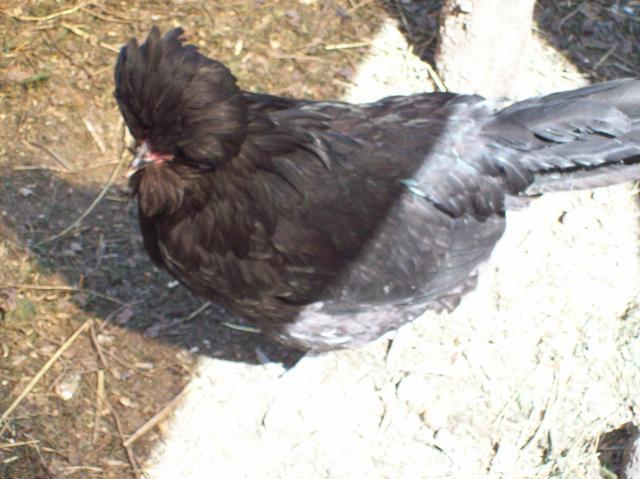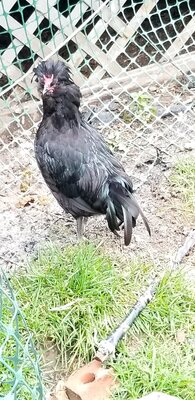- Dec 21, 2009
- 1,433
- 17
- 153
Looked at the breed list and it wasn't there!!!!!!! I thought we needed this thread in order to promote and protect this beautiful crested breed that deserves to be noticed. I never realized how rare they are! I went to the Eastern States National and there wasn't ONE there!!!! Share your pictures, tell about your Crevies, and just discuss the breed!!!!!!!!!!!!!!

Crevecoeur Info!!!:
My Pet Chicken
McMurray Hatchery
Feathersite
Polish Breeders Club, Includes Crevecoeur
Backyard Chickens
Article On Houdans&Crevecoeur
ALBC
APA STANDARD: Large Fowl: Text - 152-153, Picture - 164 Bantam: Text - 273 Picture - None
APA STANDARD: Page 2, Post #15, Thank you Boggy Bottom Bantams!
OTHER BREEDS RELATED TO/CLOSE TO CREVIES: Page 20,Post #196, Includes pics of other breeds and map.posted by Exop... Thanks!!!
IF YOU HAVE ANY MORE, PM ME!!!!!!
Colors!!!
Black, although Blue and white in other countries
The other colors were "created" during the Victorian poultry craze of the late 1800s, by crossing with Polish. This was during the same time period when the Crèvecoeur (the normal black version) was a major eating fowl in France ... and was considerably larger than it is today. The color variants were never really widespread. There are also some closely related breeds (Merlerault, Caumont, Pavilly) all black, from other parts of Normandy, which share some of its features (the Merlerault is similar to a Crèvecoeur without a beard). As far as I know none of them were ever imported into the US. (Thank you exop for that last blurb
 )
)
Breeders!!!
Boggy Bottom Bantams- Very tame birds- Bearded Crevecoeur Bantams (One of the only breeders!) Available
Rare Feathers Farm- Birds that are a joy to be around- Standard, SQ Crevecoeur Many egg auctions up!!!
Exop- Large Fowl SQ Crevecoeur- Indiana- In spring eggs and started birds available!!!
If you're a breeder, PM me, and I'll add you to the list with what kind you breed and what you sell!!!
Also, I only have "active" breeders on the list... If I took your name off of the list, then it means I haven't heard from you in awhile!!!
I only have one Crevie......she lays a white egg just about every day.....
Here's a picture of her, her name is Jet (I'll get some more later):


Crevecoeur Info!!!:
My Pet Chicken
McMurray Hatchery
Feathersite
Polish Breeders Club, Includes Crevecoeur
Backyard Chickens
Article On Houdans&Crevecoeur
ALBC
APA STANDARD: Large Fowl: Text - 152-153, Picture - 164 Bantam: Text - 273 Picture - None
APA STANDARD: Page 2, Post #15, Thank you Boggy Bottom Bantams!
OTHER BREEDS RELATED TO/CLOSE TO CREVIES: Page 20,Post #196, Includes pics of other breeds and map.posted by Exop... Thanks!!!
IF YOU HAVE ANY MORE, PM ME!!!!!!
Colors!!!
Black, although Blue and white in other countries
The other colors were "created" during the Victorian poultry craze of the late 1800s, by crossing with Polish. This was during the same time period when the Crèvecoeur (the normal black version) was a major eating fowl in France ... and was considerably larger than it is today. The color variants were never really widespread. There are also some closely related breeds (Merlerault, Caumont, Pavilly) all black, from other parts of Normandy, which share some of its features (the Merlerault is similar to a Crèvecoeur without a beard). As far as I know none of them were ever imported into the US. (Thank you exop for that last blurb

Breeders!!!
Boggy Bottom Bantams- Very tame birds- Bearded Crevecoeur Bantams (One of the only breeders!) Available
Rare Feathers Farm- Birds that are a joy to be around- Standard, SQ Crevecoeur Many egg auctions up!!!
Exop- Large Fowl SQ Crevecoeur- Indiana- In spring eggs and started birds available!!!
If you're a breeder, PM me, and I'll add you to the list with what kind you breed and what you sell!!!
Also, I only have "active" breeders on the list... If I took your name off of the list, then it means I haven't heard from you in awhile!!!
I only have one Crevie......she lays a white egg just about every day.....
Here's a picture of her, her name is Jet (I'll get some more later):

Last edited:



